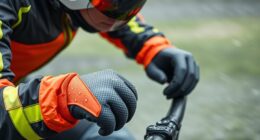Research shows that impact forces play a key role in determining injury severity during accidents or sports. Higher impact forces increase your risk of serious injuries like fractures or concussions. Wearing properly designed and fitted protective gear can absorb or redirect these forces, reducing injury risks. Understanding how impact forces work helps you make safer choices and improves safety standards. Keep exploring to learn more about how biomechanics influence injury prevention and the design of effective protective equipment.
Key Takeaways
- Higher impact forces increase the likelihood and severity of injuries during accidents or physical activities.
- Biomechanics research helps identify vulnerable body regions and optimal protective gear design.
- Properly designed and fitted protective equipment reduces force transmission and injury risk during impacts.
- Impact testing standards ensure safety gear can withstand specific force thresholds, enhancing protection.
- Understanding impact dynamics informs injury prevention strategies and improves safety protocols across activities.

Understanding impact forces is essential because they directly influence the likelihood and severity of injuries during accidents or physical activities. When you experience a collision or sudden jolt, the force exerted on your body determines whether you walk away unscathed or face serious harm. This is where the role of protective gear becomes critical. Quality helmets, pads, and other safety equipment are designed based on principles derived from biomechanics analysis, which helps scientists understand how forces transfer through your body during impacts. By studying how impact forces behave, manufacturers can develop gear that absorbs or redirects energy, reducing the risk of injuries like fractures, concussions, or soft tissue damage.
Impact forces influence injury risk; biomechanics guides safety gear design to absorb and redirect energy effectively.
Biomechanics analysis offers valuable insights into how your body responds to different impact scenarios. It involves examining how forces act on bones, muscles, and joints during collisions, providing data on which areas are most vulnerable and how to strengthen or protect them. For example, research shows that the design of a helmet must account for both the magnitude and direction of impact forces to effectively cushion your head. When impact forces are high, the protective gear’s material deforms or absorbs energy, minimizing the force transmitted to your skull and brain. This understanding allows engineers to optimize gear for maximum impact attenuation, which can make the difference between a minor injury and a severe one. Additionally, advances in protective gear design leverage biomechanics data to improve impact absorption capabilities.
You also play a role in managing impact forces through proper use of protective gear. Wearing the right equipment tailored to your activity and correctly fitted ensures that the gear functions as intended. For instance, a helmet that doesn’t sit snugly won’t absorb impacts effectively, leaving your head vulnerable. Similarly, pads that are too loose won’t distribute forces properly, increasing injury risk. The science behind biomechanics analysis underscores the importance of selecting gear designed for specific impacts and activities, whether you’re cycling, skateboarding, or participating in contact sports.
Furthermore, understanding impact forces helps you appreciate why safety standards and testing protocols exist. Manufacturers conduct rigorous impact tests to evaluate how well protective gear performs under realistic conditions. These tests simulate impact forces you might encounter, ensuring gear can withstand specific thresholds without failing. By adhering to these standards, you’re better protected from the unpredictable nature of impacts during sports or accidents. In essence, grasping the science behind impact forces and biomechanics analysis empowers you to make informed choices about safety equipment, ultimately reducing injury risks and enhancing your overall safety during physical activities.
Frequently Asked Questions
How Do Individual Factors Influence Injury Risk From Impact Forces?
Your individual factors, like biomechanical variations and genetic predispositions, markedly influence your injury risk from impact forces. If your biomechanics cause uneven force distribution or joint instability, you’re more prone to injuries. Similarly, genetic factors can affect tissue strength and healing capacity. By understanding these factors, you can take targeted precautions, improve your technique, and reduce your overall injury risk during physical activities.
What Role Does Protective Gear Play in Reducing Impact Injuries?
Ever wonder how you can reduce injury risk during impacts? Protective gear plays a vital role in injury mitigation by absorbing and dispersing impact forces, preventing them from reaching your body. When you wear the right gear, you actively decrease the severity of injuries, especially in high-risk activities. So, isn’t it smart to always use protective gear to keep yourself safe and minimize injury risk during any impact?
Are Certain Sports or Activities More Prone to High-Impact Injuries?
Certain sports or activities are more prone to high-impact injuries due to their biomechanics. Sports like football, rugby, and skateboarding involve rapid movements and collisions, increasing injury risk. By understanding sports biomechanics, you can better implement injury prevention strategies. Wearing protective gear and practicing proper techniques help reduce impact forces, making high-impact sports safer. Awareness of these factors allows you to enjoy your activity while minimizing injury chances.
How Can Training Modify Impact Forces to Prevent Injuries?
You can modify impact forces and prevent injuries by focusing on muscle strengthening and technique optimization. Building strength helps absorb shocks better, reducing strain during impacts. Additionally, refining your technique ensures proper movement mechanics, which lessens the force exerted on joints and tissues. Consistent training in these areas makes your body more resilient, helping you withstand impacts safely and lowering injury risks during high-impact activities.
What Advancements Are Being Made in Impact Force Measurement Technology?
Did you know that impact force measurement technology has advanced by over 50% in accuracy recently? You’ll find sensor innovations like flexible, wearable devices that capture real-time data. These sensors, combined with sophisticated data analytics, allow you to analyze impact forces with greater precision. This progress helps you better understand injury risks and optimize training, making injury prevention more effective and personalized than ever before.
Conclusion
Understanding impact forces helps you recognize how injuries happen and how to prevent them. By staying aware and using proper techniques, you can reduce your risk considerably. Are you willing to prioritize safety and take the necessary steps to protect yourself? Remember, knowledge is power—when you understand the forces at play, you’re better equipped to stay safe and avoid harm in every activity. So, will you choose caution over risk today?









